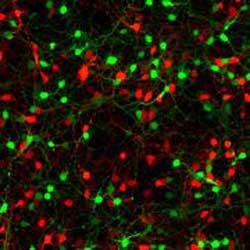How the brain communicates

Nerve cells of both hemispheres in the brain have to communicate with each other so that the body can perform certain functions. Photo: Philipp Mergenthaler<br>
The findings, which appear in the current issue of the journal Science, provide new insights into nerve cell communication in the brain that could also play a role in stroke.
On the way to the brain, nerve pathways in the human body cross each other. As a result, stimuli are processed in the opposite hemisphere of the brain. For example, if someone touches our right hand, the stimulus is received in the left half of the brain.
However, both halves of the brain have to coordinate their activities. Since some functions, such as language, are strongly pronounced in only one half of the brain, their signals always have to be communicated to the other half. This is even more obvious in daily activities such coordinating the hands or feet, which requires very precise communication between both brain hemispheres. The signals that reach the brain hemispheres are sent via a massive nerve pathway called the corpus callosum from one half of the cerebral cortex to the other.
The research group of Matthew Larkum of the Cluster of Excellence NeuroCure at the Charité – Universitätsmedizin Berlin and Humboldt-Universität zu Berlin investigates the mechanisms in the brain controlling neuron activity in the cerebral cortex. In their current study in cooperation with the University of Bern, the researchers focused on the processing of tactile sensations. To do this Larkum and his team used a range of methods such as intracellular measurements of single nerve cells in the intact brain and various imaging techniques during the sensory stimulation of the hind paw of a rat.
The scientists discovered that stimulating the right and left paws of the rat has a relatively slow, nearly half-second-long sustained inhibitory effect on nerve cell activity. „That is very slow“, notes Larkum. „Normally, signal transmission happens much faster. For that reason, we wanted to find out which circuit of nerves underlies this mechanism and identify the cellular communication pathways,“ he further explains.
The researchers were able to do this with the help of a new technology called optogenetics, which makes it possible to stimulate specific nerves with light. The researchers could show that nerve fibers coming out of the opposite hemisphere activate a special group of local inhibitory nerve cells. These nerve cells in turn activate slow-acting receptors that lead to lower activity in the other nerve cells of the same brain hemisphere.
For stroke research in particular, these findings could be an additional building block in the development of new therapies, as this mechanism plays an important role in the disease. However, communication between the brain hemispheres in the cerebral cortex is crucial not only in stroke damage but also for a range of cognitive abilities, which is why the results of this study could have far-reaching impact.
NeuroCure is a Cluster of Excellence at the Charité – Universitätsmedizin Berlin funded as part of the Excellence Initiative of the German federal and state governments. The focus of this interdisciplinary research alliance is on translating results from basic neuroscience research into clinical application. A better understanding of underlying disease mechanisms contributes to developing effective treatments for neurological diseases such as stroke, multiple sclerosis and epilepsy.
In addition to the Charité, NeuroCure partners include the Humboldt-Universität zu Berlin, Freie Universität Berlin, Max Delbrück Center for Molecular Medicine (MDC), Leibniz Institute for Molecular Pharmacology (FMP) and Deutsches Rheuma-Forschungszentrum (DRFZ).
Selected publications:
Palmer LM, Schulz JM, Murphy SC, Ledergerber D, Murayama M, Larkum ME (2012) The cellular basis of GABAB-mediated interhemispheric inhibition. Science In press.
Kontakt:
Prof. Dr. Matthew Larkum
Neuroscience Research Center
Charité – Universitätsmedizin Berlin
Tel: +49 30 450 528152
Email: matthew.larkum@gmail.com
Media Contact
More Information:
http://www.hu-berlin.de/All latest news from the category: Life Sciences and Chemistry
Articles and reports from the Life Sciences and chemistry area deal with applied and basic research into modern biology, chemistry and human medicine.
Valuable information can be found on a range of life sciences fields including bacteriology, biochemistry, bionics, bioinformatics, biophysics, biotechnology, genetics, geobotany, human biology, marine biology, microbiology, molecular biology, cellular biology, zoology, bioinorganic chemistry, microchemistry and environmental chemistry.
Newest articles

Silicon Carbide Innovation Alliance to drive industrial-scale semiconductor work
Known for its ability to withstand extreme environments and high voltages, silicon carbide (SiC) is a semiconducting material made up of silicon and carbon atoms arranged into crystals that is…

New SPECT/CT technique shows impressive biomarker identification
…offers increased access for prostate cancer patients. A novel SPECT/CT acquisition method can accurately detect radiopharmaceutical biodistribution in a convenient manner for prostate cancer patients, opening the door for more…

How 3D printers can give robots a soft touch
Soft skin coverings and touch sensors have emerged as a promising feature for robots that are both safer and more intuitive for human interaction, but they are expensive and difficult…





















